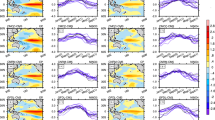Abstract
We implement a hierarchical Bayesian spatiotemporal (HBST) model to forecast the daily trapped particle flux distribution over the South Atlantic Anomaly (SAA) region. The National Oceanic and Atmospheric Administration (NOAA)-15 data from 1–30 March 2008 with particle energies as >30 keV (mep0e1) and >300 keV (mep0e3) for electrons and 80–240 keV (mep0p2) and > 6900 keV (mep0p6) for protons were used as the model input to forecast the flux values on 31 March 2008. Data were transformed into logarithmic values and gridded in a 5∘×5∘ longitude and latitude size to fulfill the modelling precondition. A Monte Carlo Markov chain (MCMC) was then performed to solve the HBST Gaussian Process (GP) model by using the Gibbs sampling method. The result for this model was interpolated by a Kriging technique to achieve the whole distribution figure over the SAA region. Statistical results of the root mean square error (RMSE), mean absolute percentage error (MAPE), and bias (BIAS) showed a good indicator of the HBST method. The statistical validation also indicated the high variability of particle flux values in the SAA core area. The visual validation showed a powerful combination of HBST-GP model with Kriging interpolation technique. The Kriging also produced a good quality of the distribution map of particle flux over the SAA region as indicated by its small variance value. This suggests that the model can be applied in the development of a Low Earth Orbit (LEO)-Equatorial satellite for monitoring trapped particle radiation hazard.






Similar content being viewed by others
References
Bakar K S and Sahu S K 2013 spTimer: Spatio-temporal Bayesian modeling using R; Technical Report, School of Mathematics, University of Southampton.
Fok M C, Wolf R A, Spiro R W and Moore T E 2001 Comprehensive computational model of the earth’s ring current; J. Geophys. Res. 106 8417–8424, doi: 10.1029/2000JA000235.
Fok M C, Glocer A, Zheng Q, Horne R B, Meredith N P, Albert J M and Nagai T 2011 Recent developments in the radiation belt environment model; J. Atmos. Sol. Terr. Phys. 73 1435–1443.
Furrer R, Nychka D and Sain S 2013 Fields: Tools for spatial data; R package version 6.7.6, http://CRAN.R-project.org/package=fields .
Gelfand A E 2012 Hierarchical modeling for spatial data problems; Spatial Stat. 1 30–39.
Horne R B, Glaurent S A, Meredith N P, Boscher D, Maget V, Heynderickx D and Pitchford D 2013 Space weather impact on satellites and forecasting the earth’s electron radiation belts with SPACECAST; Space Weather 11 169–186, doi: 10.1002/swe.20023.
Milliff R F, Bonazzi A, Wikle C K, Pinardi N and Berliner L M 2011 Ocean ensemble forecasting. Part I: Ensemble mediterranean winds from a bayesian hierarchical model; Quart. J. Roy. Meteorol. Soc. 137 (657) 858–878.
Pierrard V, Goldstein J, Andre N, Jordanova V K, Kotova G A, Lemaire J F, Liemohn M W and Matsui H 2009 Recent progress in physics-based models of the plasmasphere; Space Sci. Rev. 145 193–229, doi: 10.1007/978-1-4419-1323-4_7.
R Core Team 2013 R: A language and environment for statistical computing; R Foundation for Statistical Computing, Vienna, Austria, ISBN 3-900051-07-0, http://www.R-project.org/.
Riccio A, Barone G, Chianese E and Giunta G 2006 A hierarchical bayesian approach to the spatio-temporal modeling of air quality data; Atmos. Environ. 40 (3) 554–566, doi: 10.1016/j.atmosenv.2005.09.070.
Sahu S K and Bakar K S 2012 Hierarchical bayesian autoregressive models for large space-time data with application to ozone concentration modeling; Appl. Stochastic Models Bus. Ind. 28 395–415, doi: 10.1002/asmb.1951.
Sahu S K, Bakar K S and Awang N 2013 Bayesian forecasting using hierarchical spatio-temporal models with applications to ozone levels in the eastern United States; Technical Report, School of Mathematics University of Southampton, http://www.personal.soton.ac.uk/sks/research/papers/sahubakarandwang2013.pdf.
Suparta W, Gusrizal, Ali M A M and Ahmad N 2013. Proc. 2013 IEEE Intern. Conf. Space Sci. Comm. (ICONSPACE), pp. 17–22, doi: 10.1109/IconSpace.2013.6599425.
Tóth G et al. 2005 Space weather modeling framework: A new tool for the space science community; J. Geophys. Res. 110 A12226, doi: 10.1029/2005JA011126.
Vette J I 1991a The AE-8 trapped electron model environment; Annual Report, National Space Science Data Center (NSSDC)/World Data Center (WDC) 91–24.
Vette J I 1991b The NASA/national space science data center trapped radiation environment model program (1964–1991); Annual Report, National Space Science Data Center (NSSDC)/World Data Center (WDC) 91–29.
Acknowledgements
This study was supported by the Ministry of Science, Technology and Innovation Malaysia (MOSTI) under Science Fund 06-01-02-SF0808 grant. The authors sincerely thank National Oceanic and Atmospheric Administration (NOAA) USA for the data used. Special thanks to Mr. Muhammad Marizal for his advice on R programming.
Author information
Authors and Affiliations
Corresponding author
Rights and permissions
About this article
Cite this article
Suparta, W., Gusrizal The application of a hierarchical Bayesian spatiotemporal model for forecasting the SAA trapped particle flux distribution. J Earth Syst Sci 123, 1287–1294 (2014). https://doi.org/10.1007/s12040-014-0459-3
Received:
Revised:
Accepted:
Published:
Issue Date:
DOI: https://doi.org/10.1007/s12040-014-0459-3




